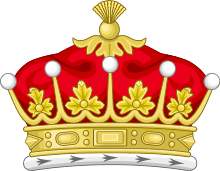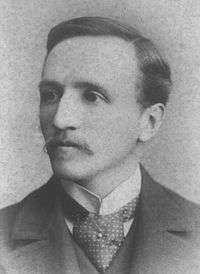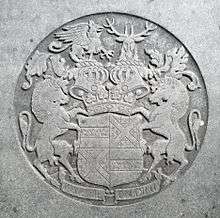Earl of Plymouth
Earl of Plymouth is a title that has been created three times: twice in the Peerage of England and once in the Peerage of the United Kingdom.
| Earldom of Plymouth | |
|---|---|
  Arms of Windsor-Clive: Quarterly: 1st & 4th, Argent, on a Fess Sable, three Mullets Or (Clive); 2nd & 3rd, Gules, a Saltire Argent, between twelve Crosses-Crosslet Or (Windsor). Crests: 1st: a Griffin statant Argent, ducally gorged Gules (Clive). 2nd: a Stag’s Head affrontée, couped at the neck Argent, attired Or (Windsor). Supporters: On either side a Unicorn Argent, armed, maned, tufted and unguled Or. | |
| Creation date | 18 December 1905 (3rd Creation) |
| Creation | Third |
| Monarch | Edward VII |
| Peerage | Peerage of the United Kingdom |
| First holder | Robert Windsor-Clive, 1st Earl of Plymouth |
| Present holder | Ivor Windsor-Clive, 4th Earl of Plymouth |
| Heir apparent | Robert Windsor-Clive, Viscount Windsor |
| Remainder to | the 1st Earl's heirs male of the body lawfully begotten |
| Subsidiary titles | Viscount Windsor Baron Windsor |
| Status | Extant |
| Motto | JE ME FIE EN DIEU (I trust in God) |

History
The first creation was in 1675 for Charles FitzCharles, one of the dozens of illegitimate children of King Charles II. This was one of few by his mistress Catherine Pegge. He died without heirs in 1680, when the title became extinct.
The second creation came in 1682 in favour of Thomas Hickman-Windsor, 7th Baron Windsor. The family descends from Sir Andrew Windsor, who fought at the Battle of the Spurs in 1513, where he was knighted. In 1529 he was summoned to Parliament as Baron Windsor, of Stanwell in the County of Buckingham (most of which land lay in Middlesex). His grandson, Edward, the third Baron, fought at the Battle of St Quentin in 1557. Edward's elder son Frederick, the fourth Baron, died unmarried at an early age and was succeeded by his younger brother, Henry. The latter's son, Thomas, the sixth Baron, was a Rear-Admiral in the Royal Navy. On Thomas's death in 1641, the barony fell into abeyance between his sisters.
The abeyance was terminated in 1660 in favour of his nephew, Thomas Hickman. He was the son of the Honourable Elizabeth Windsor, and her husband Dixie Hickman, and assumed the additional surname of Windsor as 7th Baron. He notably served as Governor of Jamaica and as Lord Lieutenant of Worcestershire. In 1682, he was created Earl of Plymouth, elevating his nobility, in the Peerage of England. He was succeeded by his grandson, Other who notably served as Lord Lieutenant of Cheshire, Denbigh and Flint. His grandson and namesake, Other, the fourth Earl, was Lord Lieutenant of Glamorganshire.
On the death of fourth Earl's childless grandson, Other, the sixth Earl, in 1833, the barony and earldom separated. The barony fell into abeyance between his sisters Lady Maria Windsor, wife of Arthur Hill, 3rd Marquess of Downshire, and Lady Harriet Windsor, wife of the Honourable Robert Clive, second son of Edward Clive, 1st Earl of Powis (see below for further history of the barony and Earl of Powis for earlier history of the Clive family). The sixth Earl was succeeded in the earldom by his uncle, Andrew, the seventh Earl. The seventh Earl died unmarried and was succeeded by his younger brother, Henry, the eighth Earl. The eighth Earl was childless and on his death in 1843 the earldom became extinct. The barony of Windsor remained in abeyance until 1855 when the abeyance was terminated in favour of Lady Harriet Windsor(-Clive), who became the thirteenth Baroness. The same year she re-assumed by Royal licence her maiden surname, as a prefix part. Her eldest son the Honourable Robert predeceased her and she was succeeded by her grandson, Robert, the fourteenth Baron, who was a prominent Conservative politician and held office as Paymaster-General and First Commissioner of Works.
In 1905 the earldom of Plymouth was revived in the third creation when Robert was created Viscount Windsor, of St Fagans in the County of Glamorgan, and Earl of Plymouth, in the County of Devon.[1] These titles were in the Peerage of the United Kingdom. The first Earl was succeeded by his second and only surviving son, Ivor, the second Earl, who was also a Conservative politician and served as Captain of the Honourable Corps of Gentlemen-at-Arms, Under-Secretary of State for Dominion Affairs, Under-Secretary of State for the Colonies and Under-Secretary of State for Foreign Affairs. Ivor's eldest son, Other, the third Earl, succeeded in 1943 and died on 7 March 2018 when he was succeeded by his own son, Ivor, the present fourth Earl. As a male-line descendant of the first Earl of Powis in its present creation the Earl is in far remainder to that peerage and its subsidiary titles.

Another member of the family was the Honourable Thomas Windsor, younger son of Thomas Hickman-Windsor, 1st Earl of Plymouth, who was elevated to new title Viscount Windsor in 1699. For 38 years, from 1758, extinct on the death of his son, the second Viscount, his daughter and heiress, Charlotte Jane, married John Stuart, 4th Earl of Bute and that title was revived from 1796 as a secondary subsidiary (courtesy) style under the Marquess of Bute (primarily this being Earl of Dumfries).
The family seat was Hewell Grange, Worcestershire and is Oakly Park, Bromfield near Ludlow, Shropshire, and a house in London W8.[2]
A customary male forename, said ǒðer, derives from the largely medieval written-up oral history of Saxon ancestor 'Otho' or 'Othere'.
Barons Windsor (1529)
.jpg)
- Andrew Windsor, 1st Baron Windsor (1467–1543)
- William Windsor, 2nd Baron Windsor (1498–1558)
- Edward Windsor, 3rd Baron Windsor (1532–1574)
- Frederick Windsor, 4th Baron Windsor (1559–1585)
- Henry Windsor, 5th Baron Windsor (1562–1605)
- Thomas Windsor, 6th Baron Windsor (1591–1642) (abeyant)
- Thomas Hickman-Windsor, 7th Baron Windsor (1627–1687) (abeyance terminated 1660; created Earl of Plymouth in 1682)
Earls of Plymouth; First creation (1675)
- Charles FitzCharles, 1st Earl of Plymouth (1657–1680)
Earls of Plymouth; Second creation (1682)
- Thomas Hickman-Windsor, 1st Earl of Plymouth (same man as 7th Baron Windsor)
- Other Windsor, 2nd Earl of Plymouth (1679–1725)
- Other Windsor, 3rd Earl of Plymouth (1707–1732)
- Other Lewis Windsor, 4th Earl of Plymouth (1731–1771)
- Other Hickman Windsor, 5th Earl of Plymouth (1751–1799)
- Other Archer Windsor, 6th Earl of Plymouth (1789–1833) (barony of Windsor abeyant 1833–1855)
- Andrew Windsor, 7th Earl of Plymouth (1754–1837), succeeded by his brother
- Henry Windsor, 8th Earl of Plymouth (1768–1843), earldom extinct.
Barons Windsor (1529; Reverted)
- Harriet Windsor, 13th Baroness Windsor (1797–1869) (abeyance terminated 1855)
- Robert George Windsor-Clive, 14th Baron Windsor (1857–1923) (created Earl of Plymouth in 1905)
Earls of Plymouth; Third creation (1905)

- Robert George Windsor-Clive, 1st Earl of Plymouth (same man as 14th Baron Windsor)
- Other Robert Windsor-Clive, Viscount Windsor (1884–1908)
- Ivor Miles Windsor-Clive, 2nd Earl of Plymouth (1889–1943)
- Other Robert Ivor Windsor-Clive, 3rd Earl of Plymouth (1923–2018[3])
- Ivor Edward Other Windsor-Clive, 4th Earl of Plymouth (b. 1951)
The heir apparent is the holder's son Robert Other Ivor Windsor-Clive, Viscount Windsor (b. 1981);[4]
whose heir apparent is his son Hon. Edward Other Ivor Llewellyn Windsor-Clive (b. 2019)[4]
Seat and published probate wealth
The second earl died, seized of St Fagans Castle, in 1943. His probate was sworn the next year at £1,204,429 (equivalent to about £54,600,000 in 2019).[5] The castle went (by gift) to the National Museum of Wales, becoming one of its key sites from his wife's death in 1947 (leading to his double probate) whereby the total assets amounted to £1,824,359 (equivalent to about £82,600,000 in 2019).[6]
See also
References
- "No. 27865". The London Gazette. 19 December 1905. p. 9084.
- "Plymouth, 4th Earl of, (Ivor Edward Other Windsor-Clive) (born 19 Nov. 1951)." WHO'S WHO & WHO WAS WHO. 1 Dec. 2007; Accessed 1 Aug. 2020. https://www.ukwhoswho.com/view/10.1093/ww/9780199540884.001.0001/ww-9780199540884-e-40353.
- PLYMOUTH, EARL – Death Notices – Shropshire Star Announcements
- "Person Page – 57276". The Peerage. Retrieved 12 October 2019.
- https://probatesearch.service.gov.uk Calendar of Probates and Administrations
- https://probatesearch.service.gov.uk Calendar of Probates and Administrations
- Kidd, Charles & Williamson, David (editors). Debrett's Peerage and Baronetage (1990 edition). New York: St Martin's Press, 1990,
External links
| Wikimedia Commons has media related to Windsor-Clive-Plymouth family. |
- Hansard 1803–2005: contributions in Parliament by Other Robert Ivor Windsor-Clive, 3rd Earl of Plymouth